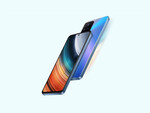Xiaomi Redmi K40S
Ausstattung / Datenblatt

Secondary Camera: 20 MPix
Preisvergleich
Testberichte für das Xiaomi Redmi K40S
Quelle: OI Spice Tech News
 EN→DE Archive.org version
EN→DE Archive.org versionSo, for the final conclusion, it would be correct to describe the Xiaomi Redmi K40S smartphone as a budget-friendly 5G smartphone equipped with striking features. A 5G phone with a straightforward layout, premium display, powerful chipset, and speedy charging, all under the Rupees 25K range. Well, the users may have to compromise a bit in the camera section otherwise everything is perfectly fine. Consumers who are satisfied with its specs must get their hands on the Redmi K40S, whenever it is available globally. Although the model is now available only in China, the customers from other countries may consider & choose from immense options prevailing in the market under this segment. If you are looking for something similar but powerful phone, you should check out the Redmi K40 Gaming or the Redmi K50 Pro meanwhile.
Einzeltest, online verfügbar, Mittel, Datum: 26.04.2022
Quelle: OI Spice Tech News
 EN→DE Archive.org version
EN→DE Archive.org versionThe Xiaomi Redmi K40S smartphone is announced in March 2022, and the phone arrived with a price tag of $280 (Rs 21,590 in India) approx. It brings the standard 6.67 inches AMOLED panel that renders an impressive 120Hz refresh rate, 1300 nits brightness, and splash-resistant features. The Redmi K40S smartphone is available in 6GB/8GB/12GB RAM with 128GB/256GB internal storage variants. The latest Android 12 OS is compatible with MIUI 13 UI. For gaming and multitasking, 7nm – Qualcomm Snapdragon 870 5G chipset and Adreno 650 GPU are present. The Xiaomi Redmi K40s smartphone comes with a triple camera setup which has a 48 MP main camera, 8 MP ultrawide, and 2MP macro lenses so that you can capture portraits, landscapes, and more. Features on the rear camera setup include Digital Zoom, Auto Flash, HDR, Face detection, and Touch to focus. With this setup, you can record up to 4K videos with no issues. On the front, the mobile features a 20 MP selfie camera so that you can click some amazing selfies and do video chats.
Einzeltest, online verfügbar, Kurz, Datum: 31.03.2022
Quelle: Igeekphone
 EN→DE Archive.org version
EN→DE Archive.org versionThe Redmi K40S is also one of the few models with a high-quality AMOLED flagship straight screen. The 120Hz high refresh rate and 360Hz touch sampling rate that can enhance the gaming experience are not absent. It also supports Dolby Vision and HDR10+ high dynamic range display. Then Atmos dual speakers. In-game or film and television experience, this Redmi K40S can bring users excellent visual enjoyment. It can be said that Redmi K40S has no shortcomings in terms of screen, performance, photography, fast charging, and other aspects. After the upgrade, it is even cheaper, starting at only 1799 yuan. It is no wonder that it is out of stock as soon as it goes on sale. Such a god-level price/performance ratio, what are you waiting for?
Einzeltest, online verfügbar, Sehr Lang, Datum: 29.03.2022
Kommentar
Qualcomm Adreno 650: Grafikchip für Smartphones und Tablets, integriert im Qualcomm Snapdragon 865 SoC. Laut Qualcomm um 25% schneller als die alte Adreno 640 im Snapdragon 855.
Diese Klasse ist noch durchaus fähig neueste Spiele flüssig darzustellen, nur nicht mehr mit allen Details und in hohen Auflösungen. Besonders anspruchsvolle Spiele laufen nur in minimalen Detailstufen, wodurch die grafische Qualität oft deutlich leidet. Diese Klasse ist nur noch für Gelegenheitsspieler empfehlenswert. Der Stromverbrauch von modernen Grafikkarten in dieser Klasse ist dafür geringer und erlaubt auch bessere Akkulaufzeiten.
» Weitere Informationen gibt es in unserem Notebook-Grafikkartenvergleich und der Benchmarkliste.
SD 870: High-End SoC (System on a Chip) für Smartphones welcher Mitte 2021 vorgestellt wurde. Integriert unter anderen einen schnellen "Prime Core" mit bis zu 3,2 GHz und drei weitere schnelle Cortex-A77 basierende Performance-Kerne. Zum Stromsparen wurden außerdem 4 weitere ARM Cortex-A55 Kerne verbaut.» Weitere Infos gibt es in unserem Prozessorvergleich Vergleich mobiler Prozessoren und der Prozessoren Benchmarkliste .

